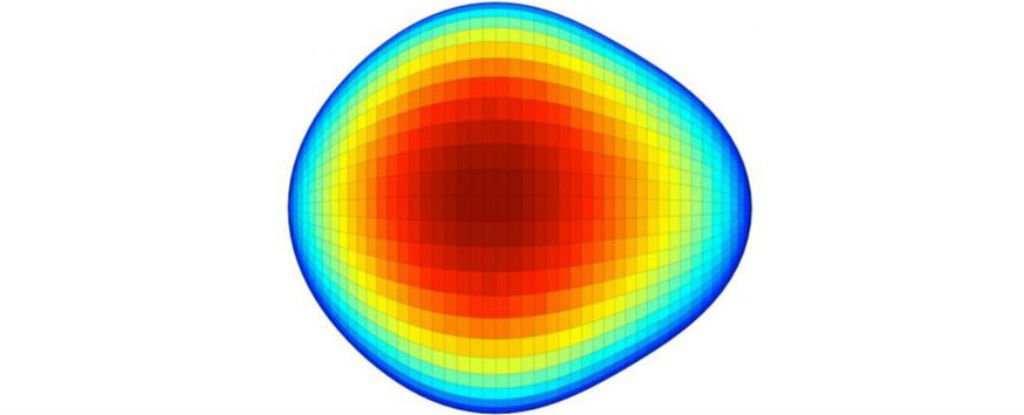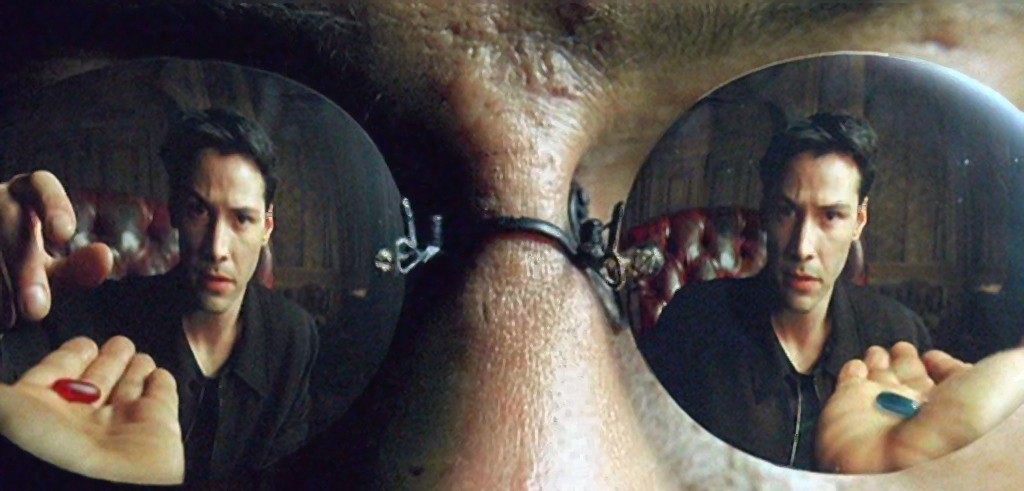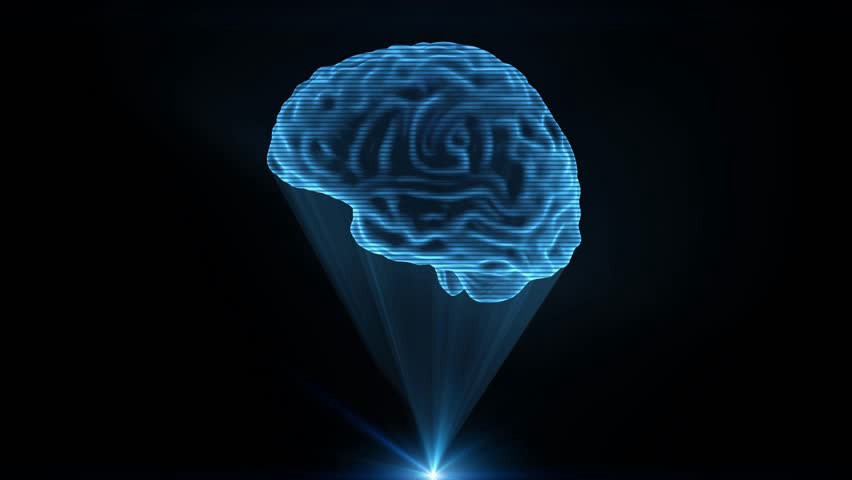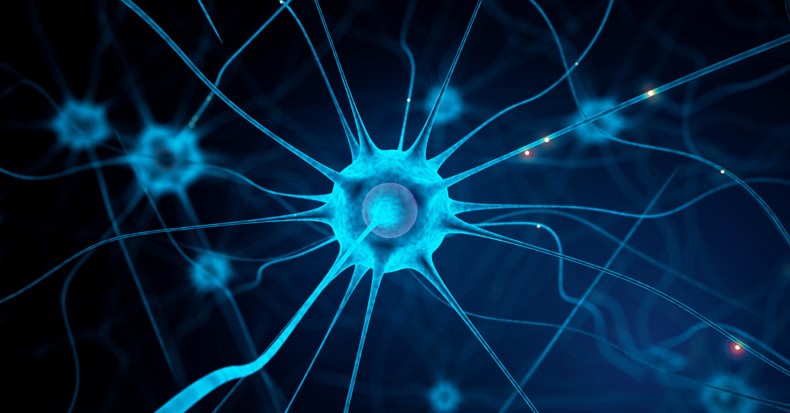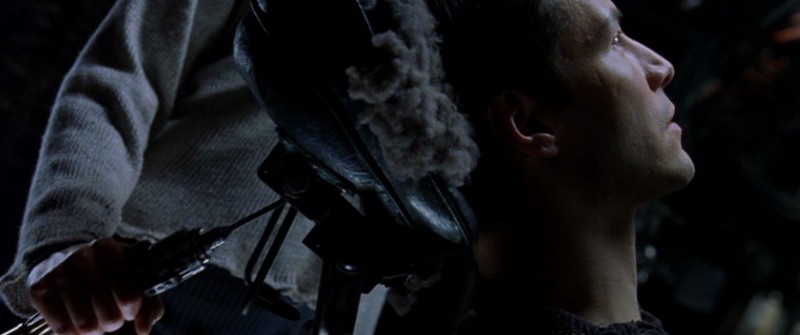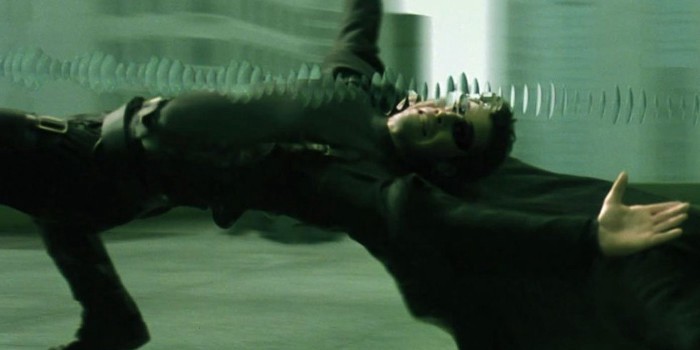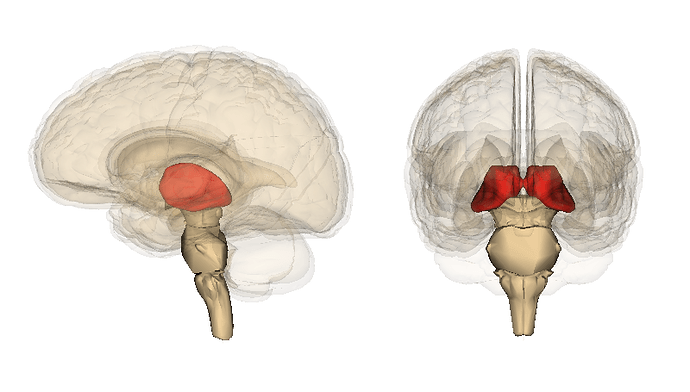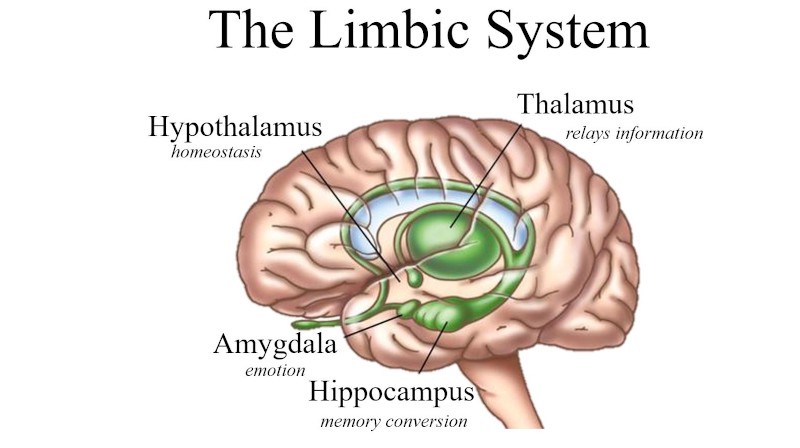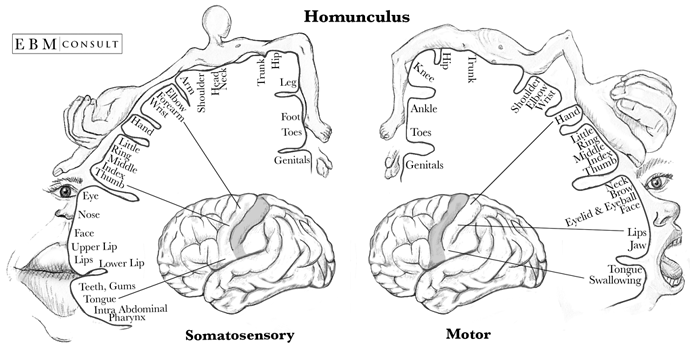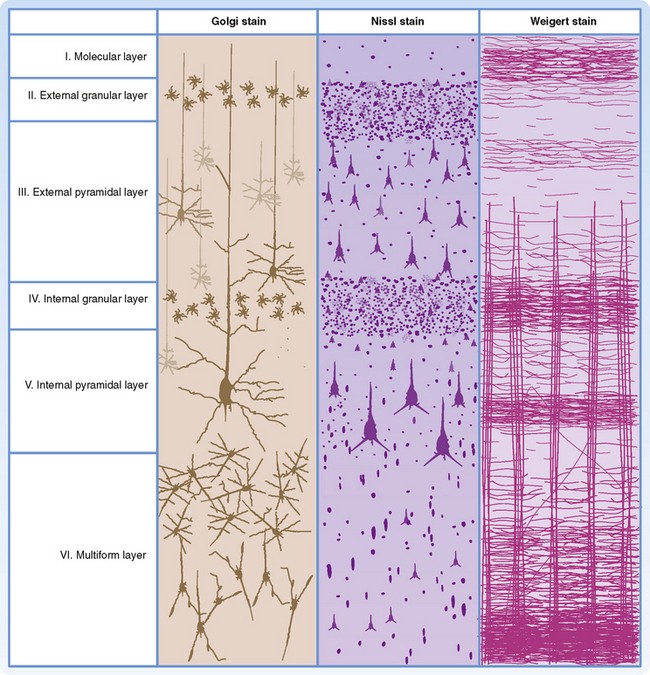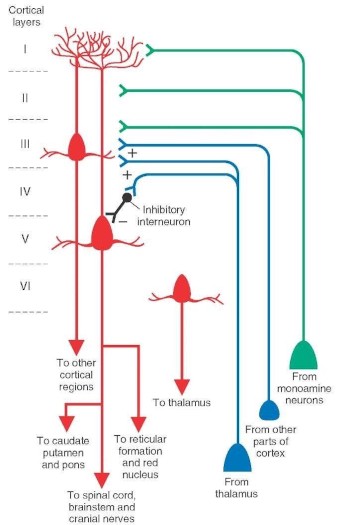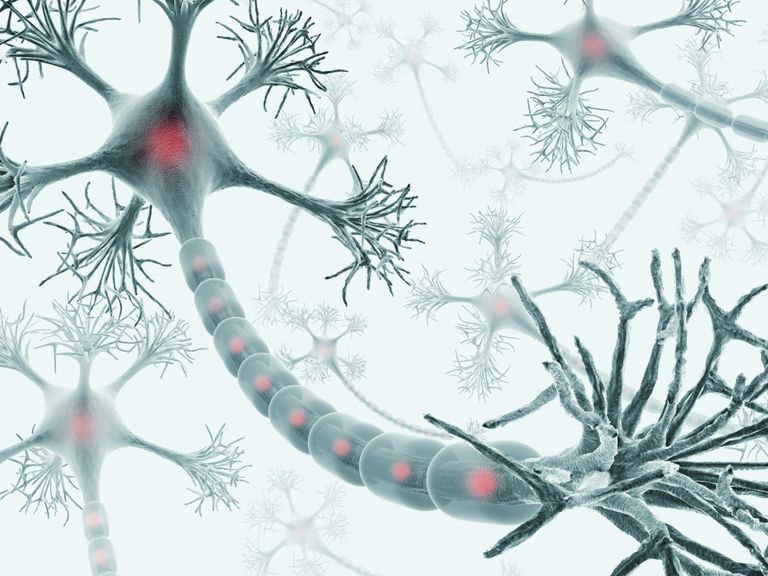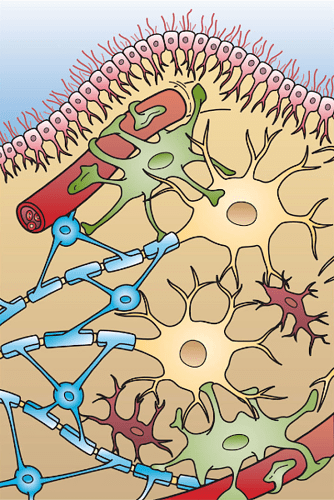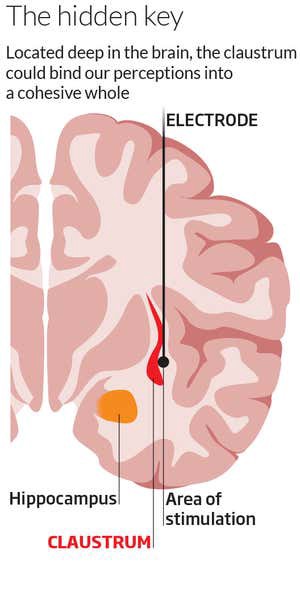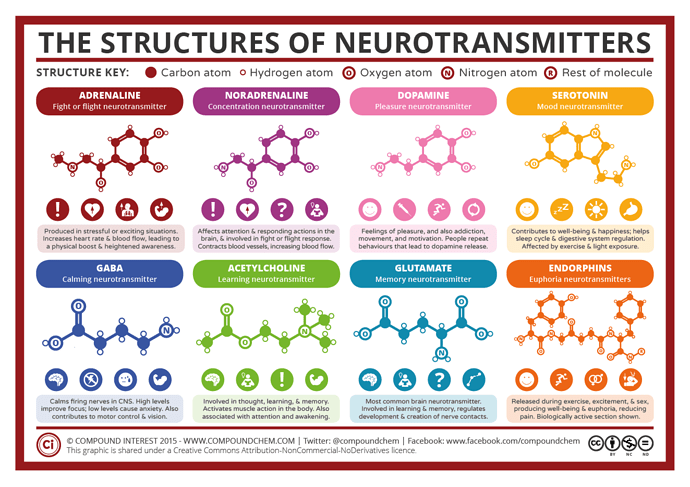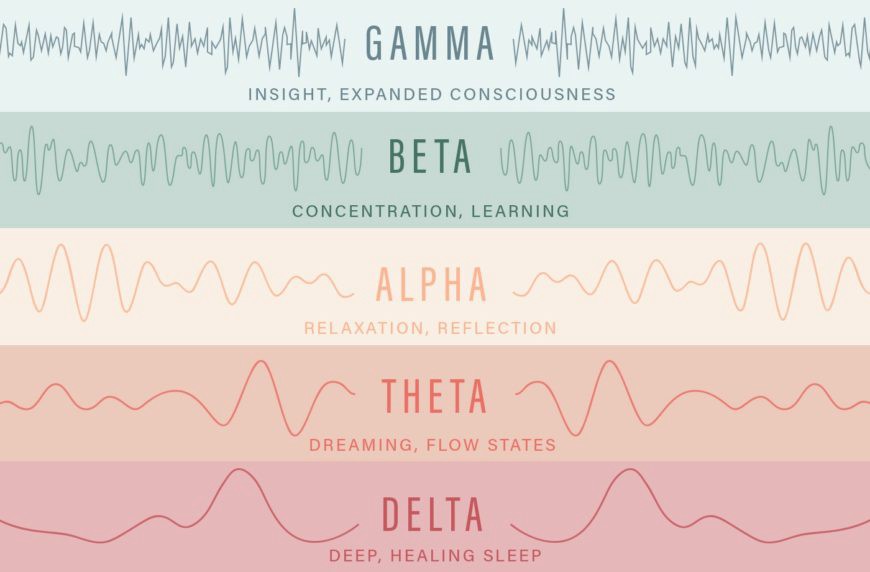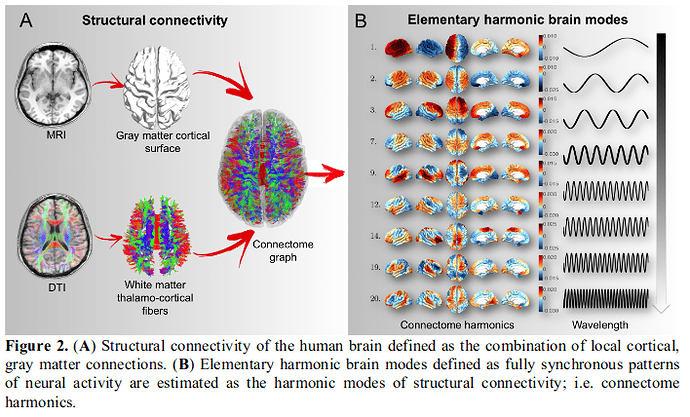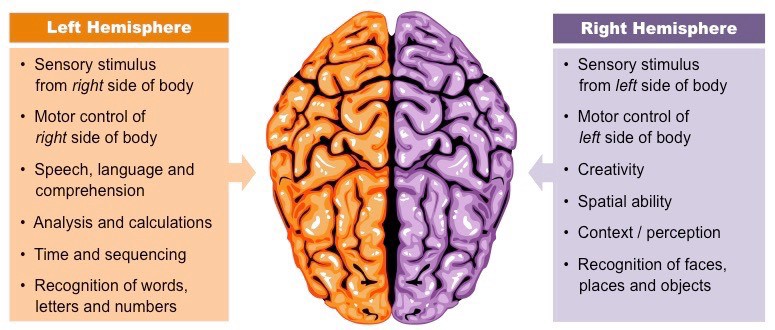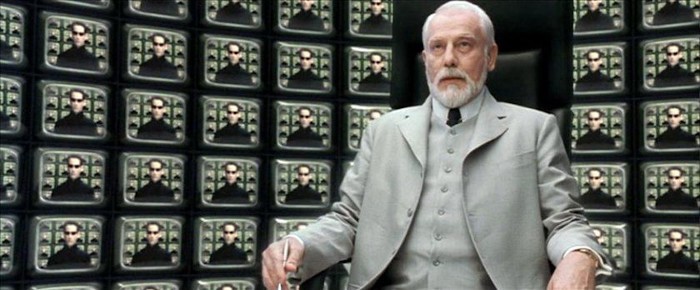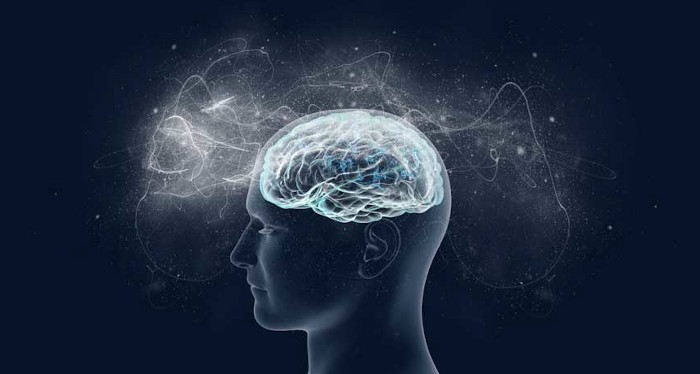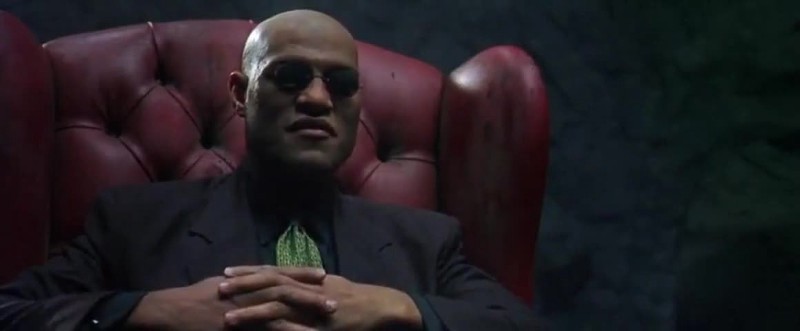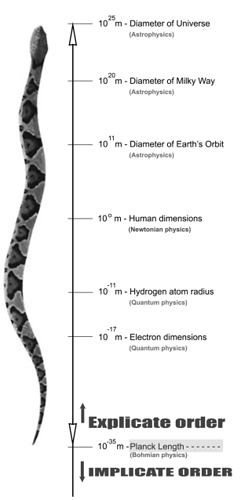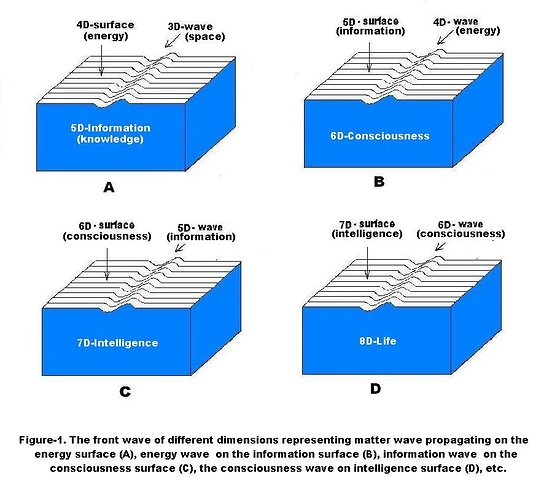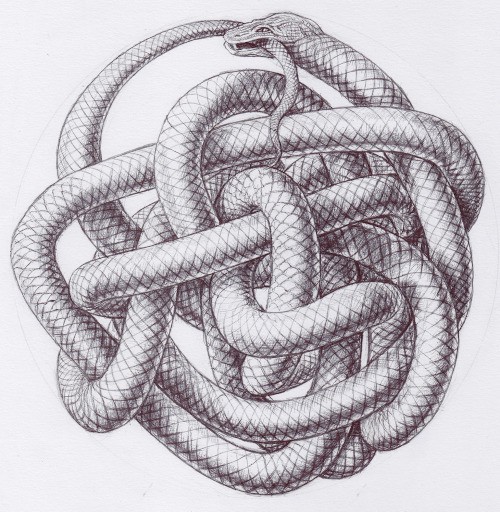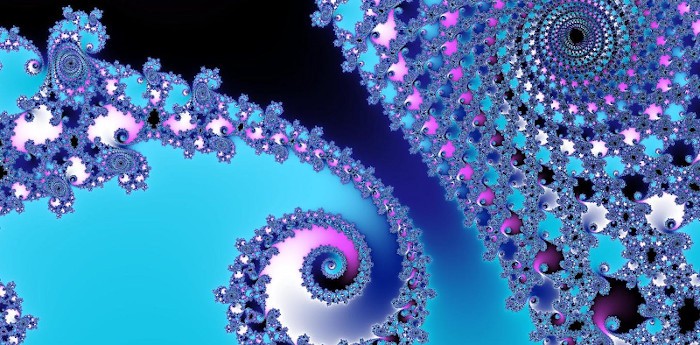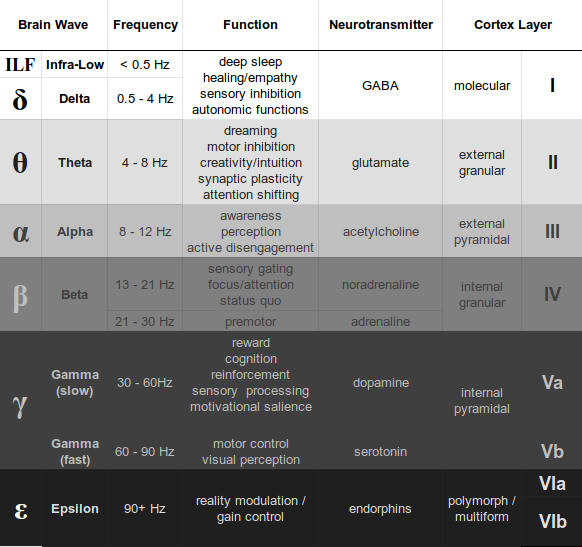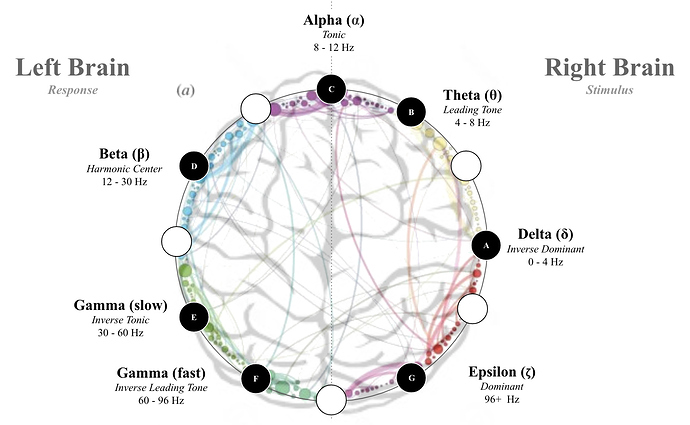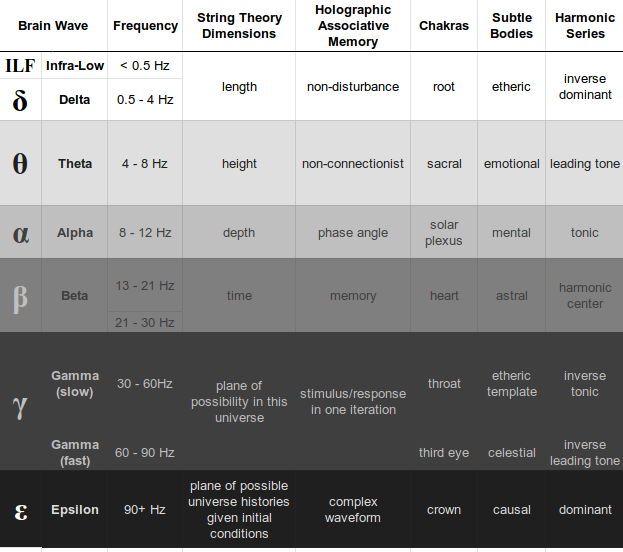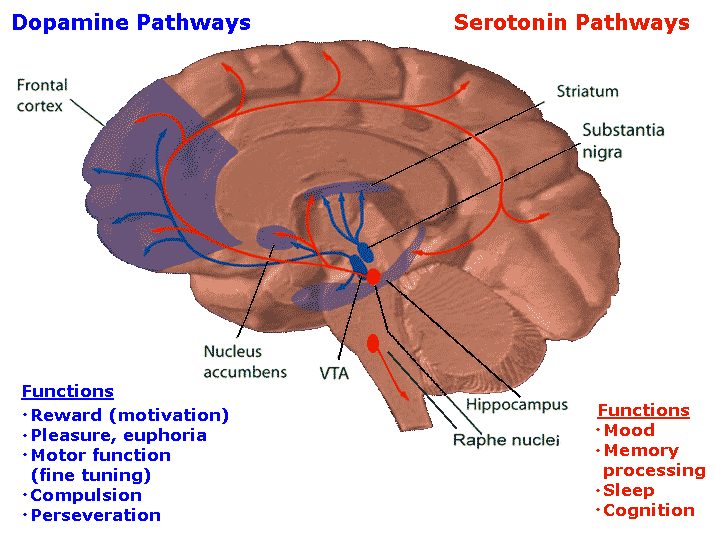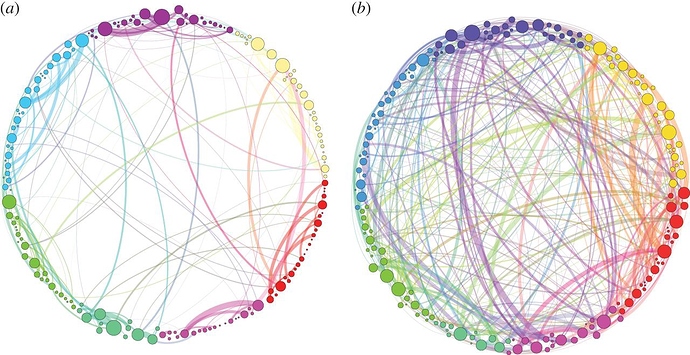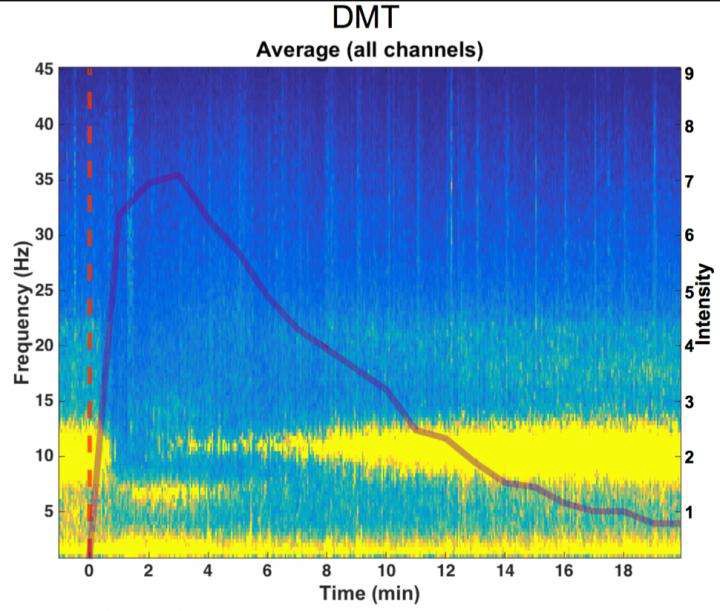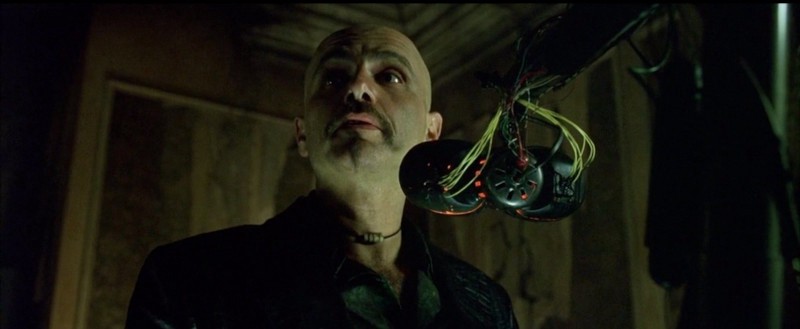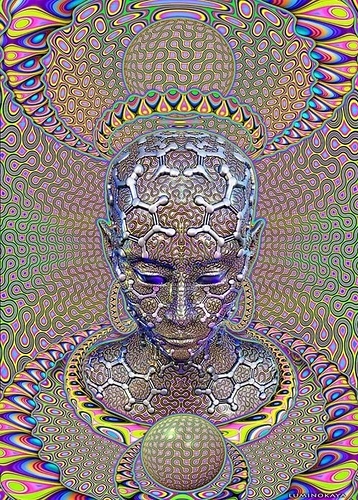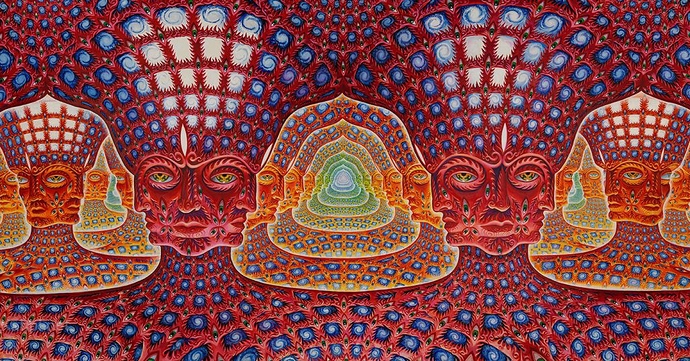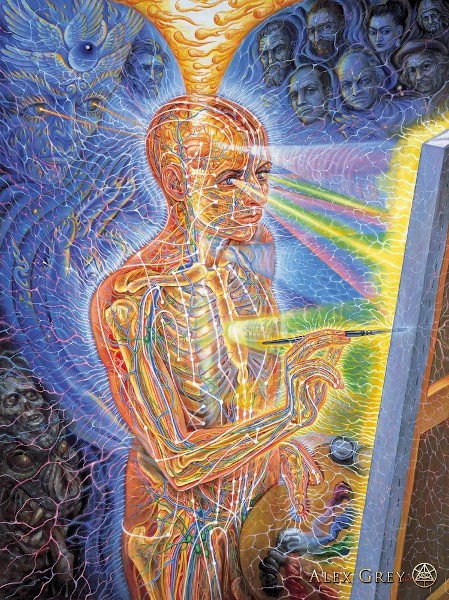@soretna , then let me make a genuine attempt to convince you - this post will keep you busy for some time :))
STATUTORY WARNING : Please ignore any comments about Big Bang Theory , Black Holes , Dark Matter and Dark Energy , that you may find in these articles below (those are all RUBBISH) - rest everything is fine !
Study reveals substantial evidence of holographic universe
by University of Southampton
A sketch of the timeline of the holographic Universe. Time runs from left to right. The far left denotes the holographic phase and the image is blurry because space and time are not yet well defined. At the end of this phase (denoted by the black fluctuating ellipse) the Universe enters a geometric phase, which can now be described by Einstein's equations. The cosmic microwave background was emitted about 375,000 years later. Patterns imprinted in it carry information about the very early Universe and seed the development of structures of stars and galaxies in the late time Universe (far right). Credit: Paul McFadden
A UK, Canadian and Italian study has provided what researchers believe is the first observational evidence that our universe could be a vast and complex hologram.
Theoretical physicists and astrophysicists, investigating irregularities in the cosmic microwave background (the 'afterglow' of the Big Bang), have found there is substantial evidence supporting a holographic explanation of the universe—in fact, as much as there is for the traditional explanation of these irregularities using the theory of cosmic inflation.
The researchers, from the University of Southampton (UK), University of Waterloo (Canada), Perimeter Institute (Canada), INFN, Lecce (Italy) and the University of Salento (Italy), have published findings in the journal Physical Review Letters .
A holographic universe, an idea first suggested in the 1990s, is one where all the information that makes up our 3-D 'reality' (plus time) is contained in a 2-D surface on its boundaries.
Professor Kostas Skenderis of Mathematical Sciences at the University of Southampton explains: "Imagine that everything you see, feel and hear in three dimensions (and your perception of time) in fact emanates from a flat two-dimensional field. The idea is similar to that of ordinary holograms where a three-dimensional image is encoded in a two-dimensional surface, such as in the hologram on a credit card. However, this time, the entire universe is encoded."
Although not an example with holographic properties, it could be thought of as rather like watching a 3-D film in a cinema. We see the pictures as having height, width and crucially, depth—when in fact it all originates from a flat 2-D screen. The difference, in our 3-D universe, is that we can touch objects and the 'projection' is 'real' from our perspective.
In recent decades, advances in telescopes and sensing equipment have allowed scientists to detect a vast amount of data hidden in the 'white noise' or microwaves (partly responsible for the random black and white dots you see on an un-tuned TV) left over from the moment the universe was created. Using this information, the team were able to make complex comparisons between networks of features in the data and quantum field theory. They found that some of the simplest quantum field theories could explain nearly all cosmological observations of the early universe.
Professor Skenderis comments: "Holography is a huge leap forward in the way we think about the structure and creation of the universe. Einstein's theory of general relativity explains almost everything large scale in the universe very well, but starts to unravel when examining its origins and mechanisms at quantum level. Scientists have been working for decades to combine Einstein's theory of gravity and quantum theory. Some believe the concept of a holographic universe has the potential to reconcile the two. I hope our research takes us another step towards this."
The scientists now hope their study will open the door to further our understanding of the early universe and explain how space and time emerged.
The Holographic Brain
Abstract
- The universe is a hologram
- The brain is a hologram tuner
- The code is creative evolution
Introduction
In the first paper, we quickly leapfrogged over some of the best theories of reality that science has to offer in order to paint a picture of the universe described by their equations.

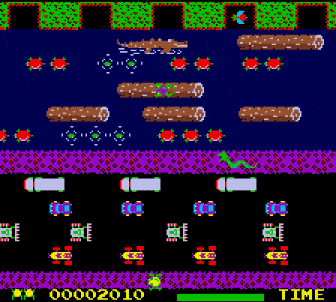
And with the theories of general relativity, quantum mechanics, and superstrings— despite some of their contradictions — we find models of the universe that are largely successful because of the accuracy of their predictions, providing empirical validation on many real-world problems.
But it’s with the implications of their assumptions — the ideas accepted without proof and on which they stand — where we can get a deeper glimpse into the possible nature of reality . Particularly the 95% of it that we have yet to observe.
And with string theory, we find in the initial assumption only a small leap of the imagination on which to base our conclusions. Conclusions that then follow logically from doing the math.

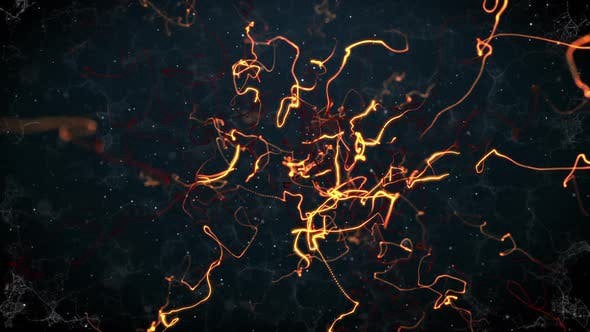
Instead of point particles, all matter and energy are modeled as vibrating string-like objects whose folding and resonant frequencies determine their properties.
By projecting this assumption into higher dimensions, we are then able to construct a mathematically consistent model of the universe integrating both general relativity and quantum mechanics, theoretically solving some of the hard problems of physics, and generally implying that:
Reality, as we experience it, is a holographic projection of quantum string entanglement on a hyper-dimensional manifold lying an infinite distance away.
Tumbling down this rabbit hole, we are led to the conclusion that the either the universe has the properties of a hologram, or the hologram has the properties of a universe. In other words:
It is the world that has been pulled over your eyes to blind you from the truth.

The universe is a black hole.
Encoded in its hidden dimensions are the histories of all possible universes.
And at its cor e, the universe is running a real-time search algorithm for novelty.
A quantum computer evolving complexity as fast as possible.
What we perceive on the event horizon is a simulation , a necessary illusion created by the brain to facilitate survival on a hyperbolic landscape of entangled strings.
And with a virtual reality headset tuned specifically to the game of natural selection , we re-construct the hologram to explore its degrees of freedom and exploit them.
The simulation , then, is the playground of evolution. A video game whose only objective is to create something new.


If this is true, if the universe is, in fact , a hologram , then it follows that like all holograms, a reference beam is needed for its re-construction.
Luckily, our nervous system provides just such a ray of light.
The Brain is a Hologram Tuner

Around 2 billion years ago, as evolution was taking baby steps toward a planet of talking apes, it stumbled on a particularly useful trick for keeping its doodles alive. Cells with a nucleus enclosed in a membrane . The eukaryotes.
And by converting external stimuli into membrane de-polarizations , the eukaryotes were able to create an electrical gradient between the inside and outside of their cells, and that was something to work with.
Fast forward a billion and a half years and these simple eukaryotes had self-organized and specialized to such a degree that complex multi-cellular organisms began evolving. And from this branching point, the animal kingdom set out on its pursuit of intelligence.
Harnessing the power of the electromagnetic force, specialized cells developed which could transmit information in the form of action potentials and cascading de-polarizations of electric fields.

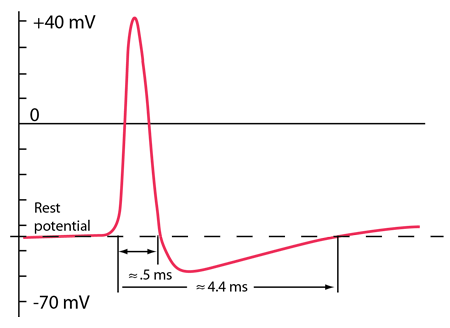
An action potential
These spikes of electricity enabled cells to communicate with each other and offered a distinct evolutionary advantage to organisms that proved efficient in their tuning.
The more adapted an organism is to its environment — the better it can sense and react to it — the greater its chances are of survival.

And thus were born the impulse conductors of our existence, the drivers of evolution and intelligence. Nerves.
The Nervous System
Broadly defined, the nervous system is a highly complex collection of nerves distributed throughout the body for the purpose of transmitting signals, and coordinating sensory and motor information between the limbs, organs, and the brain.

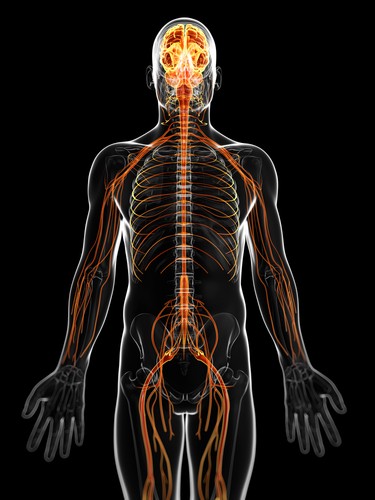
Its job is to detect changes in the environment and respond to them with coordinated movement.
Imagining the human body as a robot, the nervous system is the electrical wiring of a collection of peripheral sensors and actuators that are controlled by a computer, or central processing unit (CPU).
Peripheral Nervous System
At the periphery of the nervous system are the limbs and organs. The exoskeleton and the engine. The limbs interface with the external world and the organs keep the robot running.
In order to get signals to the brain, nerve fibers branch out from the spinal cord, projecting axons across great distances in the body. And axons are the output of nerve cells.


From the body they stretch to the inputs of neurons in the brain, providing sensory data about the world. And from the brain, they traverse the landscape of the body, impelling its motion.

Taken together, they form a real-time feedback loop of stimulus and response with the surrounding environment .
Spinal Cord
At the center of the of this feedback loop is the the spinal cord, a centralized data-bus carrying sensory and motor signals to and from the brain.

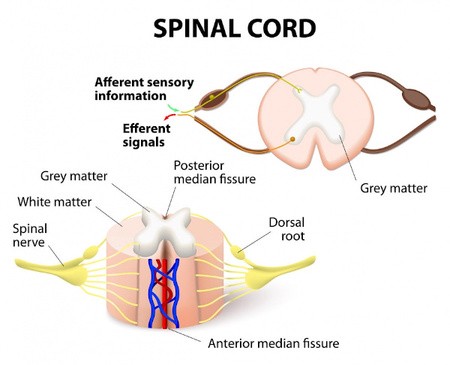
It also provides an override to the cerebral feedback loop — in the form of reflexes — should the body find itself in a compromising situation where its integrity is at risk.

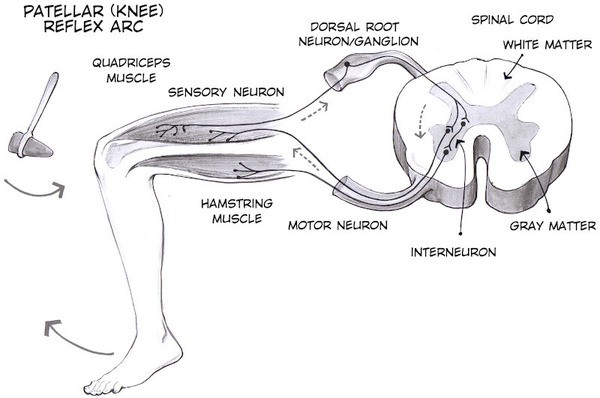
Consisting of five sections controlling different parts of the body , the spinal cord relays information through the spinal tracts to its final destination, a structure called the thalamus , in the brain.

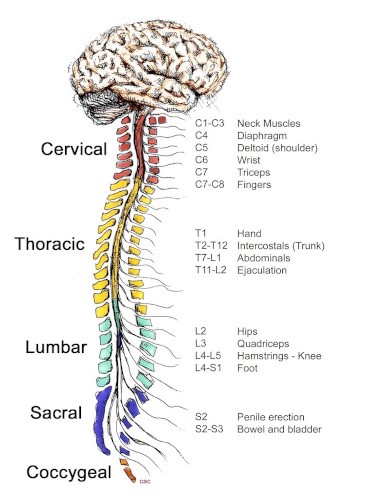
Another way to look at the spinal cord is as an antenna for the chakras , integration centers for orthogonal dimensions of the body’s experience.

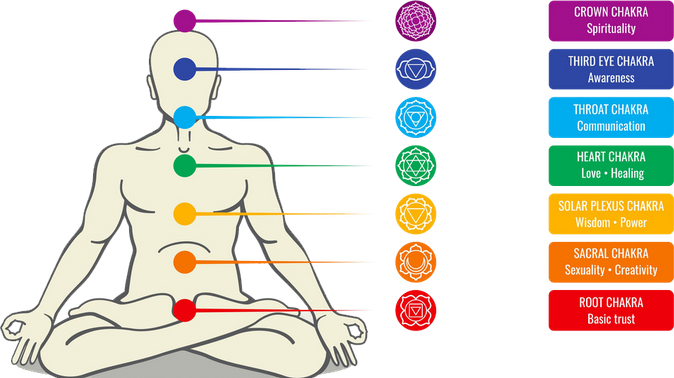
Different descriptions, same phenomena.
The Brain
At the top of the spinal cord sits the brain, the central processing unit of the robot. Before skimming over the details and jumping to conclusions, let’s take a quick look at the specs:

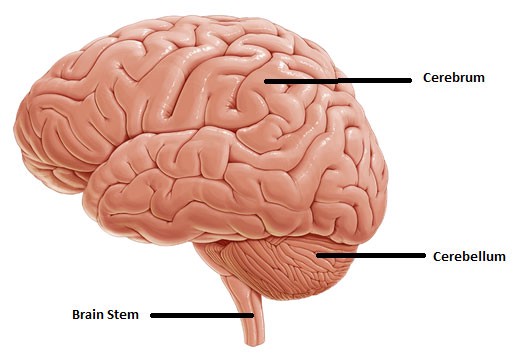
The human brain
CPU : Dual-core multi-modal processor with integrated graphics processing unit (GPU) and monitor
Neural Network: 100 billion neurons with 100 trillion synapses
Memory: 250 million Gigabytes — roughly 400 lifetimes of video stream
Display Resolution : 576 Megapixels, about 24K
Framerate : ~ 150 frames per second
Clockrate : < 1 kHz
Power Consumption : ~ 10 watts
The brain re-constructs the hologram.
And with the same amount of power as a clock radio, it does this quite efficiently.
Brain Stem
Continuing up the central nervous system, we are arrive at the brain stem which connects the spinal cord to the thalamus.
It’s how the body plugs into the brain for data processing and feedback control .

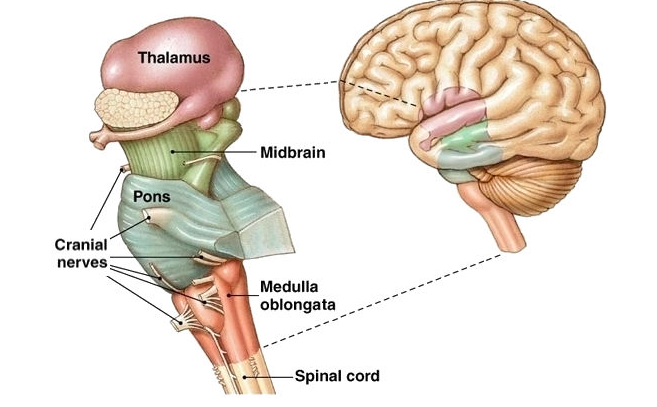
In addition to connecting the body with the mind, the brain stem is also responsible for regulating several autonomous functions, controlling basics such as heart rate, blood pressure, breathing, swallowing, and alertness.

A virtual spinal cord and brain stem
As such, it is said to be pivotal in maintaining consciousness .
Cerebellum
Hanging off the back of the brainstem is the cerebellum , which is a rather intriguing structure.


Receiving inputs from the spinal cord and other parts of the brain, its main function seems to be precision motor control , which encompasses a wide range of activities, including articulations of the thumb and motions of the mandible.
And while the cerebellum does not initiate movement , it contributes largely to the coordination, precision, and accurate timing of it. As such, it’s also responsible for motor learning , adapting and fine-tuning its motor programs through a process of trial-and-error.
But what’s really interesting is it’s structure.

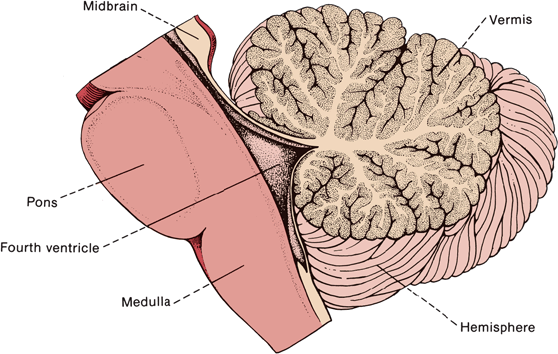
The cerebellum’s function is best understood not in terms of the behaviors it affects, but the neural computations it performs; the cerebellum consists of a large number of more or less independent modules, all with the same geometrically regular internal structure, and therefore all, it is presumed, performing the same computation .
In other words, the subtleties and nuance of motion are computed independently and on a generic system-wide architecture.
Additionally, the cerebellum is a one-way street. Input comes in from the spinal cord and other brain regions, gets refined, and the output goes right back out to motor control.
As the nervous system requires a quick and clear response to the input , the cerebellum, with its feed-foward design , is thus able to drastically reduce noise by eliminating the possibility of feedback created by recurrent neural connections.

And for a real-time biological computer, this a great performance advantage.
Studies have shown that the cerebellum is activated during language, attention, and mental imagery tasks as well. Pressing inward, “what the cerebellum is doing to movement, it’s also doing to intellect and personality and emotional processing.” [link]
The cerebellum, then, is the center of balance and refinement . Precision steering for the body and mind.
What one might call our reptilian brain.
Cerebrum
Diencephalon
At the end of the body’s information super highway is a region called the diencephalon , which literally means between-brain .
As such, it’s the relay station of sensory and motor data between the body and the brain .

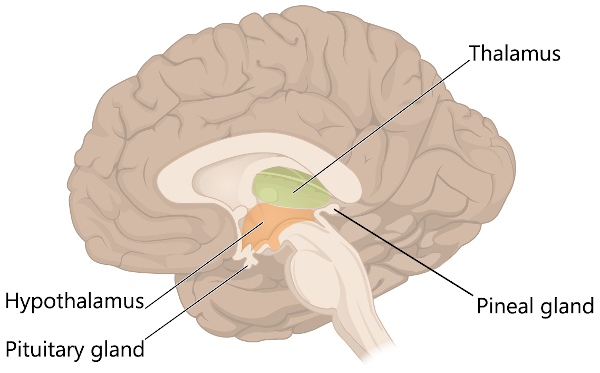
The hypothalamus connects the nervous system to the endocrine system, and the pituitary gland is basically a hormone factory under its control, regulating metabolism, growth, reproduction, sleep, mood, etc.
The thalamus is the integration hub and relay station of sensory and motor data.

It pre-processes data by transforming and integrating it, and then sends it along to the appropriate cortical regions for further computation.
The thalamus, then, is the gatekeeper to cognition . With help from the pineal gland , it also regulates states of sleep and waking consciousness.
One way to think about the thalamus is through the lens of reality modulation and gain control . It’s a bottleneck through which data about perception and movement must travel, a low-pass filter necessary for attention and focus.
The Limbic System
As data is passed between thalamus and the neocortex for cognition, it also travels through the limbic system, whose main functions are motivation, emotion, learning, and memory .

It performs lower order emotional processing of input from the sensory systems , and it is the seat of our emotional lives .
Amygdala
The amygdala’s primary function is the processing of memory, decision-making and emotional responses — including fear, anxiety, and aggression. More emotionally arousing stimuli increase the amygdala’s activity, and the level of this activity is correlated with memory retention.
Hippocampus
The hippocampus is primarily responsible for memory consolidation , transferring content from short-term and working memory to long-term storage. It also serves the function of spatial memory which prevents us from getting lost — most of the time.

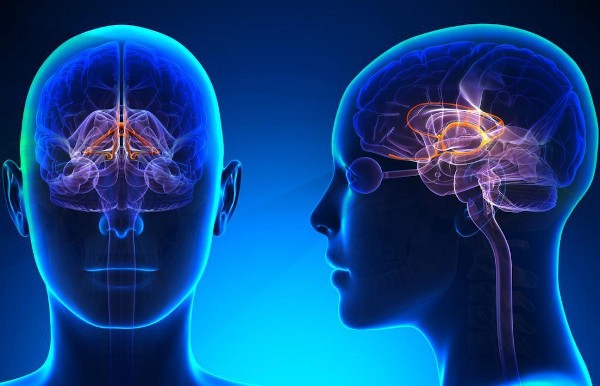
As a whole, the limbic system provides an emotional reinforcement learning algorithm for the simulation. It’s a mental map of the world with a feedback loop for our actions, mediated as they are by feelings, thereby coloring the memories we store and retrieve.
A vehicle for re-membering the hologram and navigating our way through it.
Emotion is the key to its ignition.
Neocortex
At last we have reached the end of the road for the central nervous system, a region of the brain otherwise known as the neocortex, or the seat of rational thought.

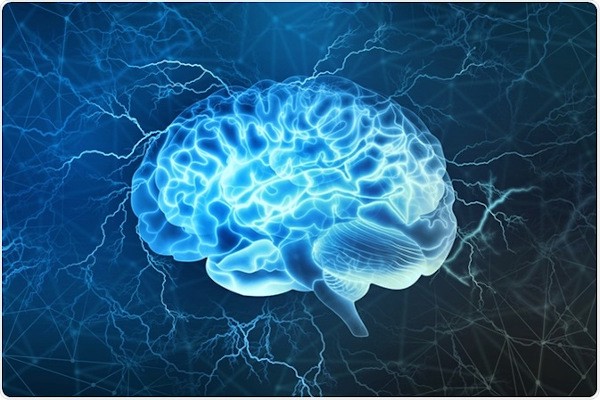
As the most recent addition to our evolutionary arsenal in the pursuit of intelligence, it’s responsible for higher-order brain functions — which include “ sensory perception, cognition, generation of motor commands, spatial reasoning, and language. ”
With its deep grooves and ridges, the folding of the neocortex drastically increases the surface area available for processing which, more or less, explains the rise of humanity.
A convoluted hyperbolic manifold .
And consisting of columns with several layers, the neocortex distributes the parallel processing of perception, thought, and action into separate modules called lobes , each responsible for a particular dimension of experience.
There are 4 lobes of the brain and they are occipital, temporal, parietal, and frontal.

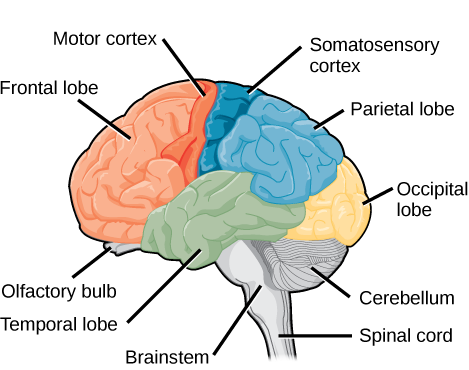
Occipital Lobe
The occipital lobe is the visual processing center of the brain. It deconstructs the visual signal of the world into parts and projects it through the lens of focus and attention.
It creates our perception of 3-dimensional space .
Temporal Lobe
The temporal lobe is the region where sound, language, and speech comprehension are processed.
In short, it is the timekeeper of the brain.
Parietal Lobe
The parietal lobe plays an important role in the integration of sensory information from the body, with the knowledge of numbers and their relations, and in the manipulation of objects.
It is the primary area of body and spatial awareness , and, in addition to the temporal lobe, holds the power of association .
Somatosensory Cortex
The somatosensory cortex is a region of the parietal lobe that receives and processes sensory input from the entire bod y.
The sense of touch. Input.

Comparison of cortical surface area mappings for somatosensory and motor cortex
Motor Cortex
And the motor cortex, a portion of the frontal lobe, manages the planning, control, and execution of voluntary movements.
The seat of action. Output
Frontal Lobe
The frontal lobe is the part of the brain that controls important cognitive skills such as “emotional expression, problem solving, memory, language, judgment, and sexual behaviors.”

Inside Out
It is the control panel to personality and our ability to communicate.
The orchestrator of thought and action in accordance with internal goals, the frontal lobe is often considered the seat of self-awareness.
Cortical Layers
With the dimensions of experience computed in parallel across the lobes, how then, do they actually compute?
In order to efficiently make sense of the world and act on it, the neurons in the neocortex evolved into 6 distinct layers , providing recurrent connections and feedback loops for data passing through the cortical columns.

The 6 layers of the neocortex
With a collection of layered neurons, we have a computational grid for performing integration and differentiation of inputs, having either excitatory or inhibitory effects on their neighbors, and producing a rather complicated neural network.
Entangled strings of neurons , if you will.
And each layer consists of a characteristic distribution of neurons and connections to other cortical and sub-cortical regions, including thalamus.
In the simplest caricature, input comes in on layer 4 , is passed to layers 2/3 for processing , and feeds to layer 5 for output to thalamus.
Additionally, layers 2/3 feed to layer 1 which also projects axons to layer 6.
Layer 6 is feedback control . It connects directly to thalamus, and influences input on layer 4 and output on layer 5.

With the recurrent connections and feedback loops of cortical laminae, we are provided the architecture of thought .
Neurons
As noted, each of the lobes of the brain consists of columns of nerve cells distributed in layers and these specialized nerve calls are neurons . They are the fundamental computational units of the brain, and when considered individually, they perform a very simple function.

A neuron with dendrites (upper left), a soma (nucleus), and an axon (lower right)
A neuron consists of dendrites (input), the soma or cell body (computer), and one axon (output). And depending on the inputs, a neuron will either fire an action potential or not in response, essentially a bit. 1 or 0.
Grey Matter
Up to this point, we have been largely exploring white matter , the tracts of nerve fibers for signals to propagate through the nervous system and the neurons themselves. The wiring, as it were.
And the distinction with white matter is its myelinated axon sheath , or insulating cover, that allows for the transmission of signals across great distances. White matter also contains relatively few cell bodies, and is composed mostly of long-range axons.
In other words, a little bit of computation and a lot of output.

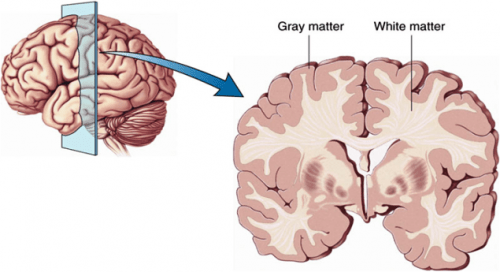
Grey matter, on the other hand, contains a large number of neuronal cell bodies but few axons.
That is, lots of computation, but little output.
Additionally, those axons are un-myelinated, meaning their influence is strictly local, and they are packed closely together.
Glial Cells
Glial cells are non-neuronal cells in the central nervous system, meaning they do not produce electrical impulses . Nonetheless, they play an important role in maintaining homeostasis by providing support and protection for the neurons.

Four different types of glial cells found in the central nervous system: ependymal cells (light pink), astrocytes (green), microglial cells (dark red), and oligodendrocytes (light blue). [link]
Additionally, glial cells are crucial to the function of neurotransmitters.
Grey matter and glial cells, taken together, are neural dark matter, the underlying bio-chemical grid supporting electrical oscillation in the brain, weakly interacting with the neurons of the white matter.
Claustrum
And one last piece to the puzzle is the claustrum.

The claustrum is a thin, bilateral surface that connects cortical regions to the thalamus.
It is the most densely connected structure in the brain allowing for integration of various cortical inputs (ex. colour, sound and touch) into one experience rather than singular events.
And due to its location deep inside the brain and with only a few cases of specific damage to this region to draw from, the study of the claustrum remains difficult.
Nonetheless, it is thought to play a key role in consciousness and sustained attention.
Ventricles
And sitting at the center of the brain, supplying it with nutrients and removing its toxins, are the ventricles. A dark space filled with cerebro-spinal fluid (CSF) that is critical to all brain functions .

During waking hours, the flow of CSF is generally restricted. And this restriction prevents the removal of toxins throughout the day, the byproducts of whatever it is that our brains are thinking about.
When we sleep, however, the brain gratuitously flushes the ventricles with CSF and removes the toxins, supplying the brain with new resources and preparing it for another wave of sensorium upon awakening— reinforcements, if you will.
And this is why it’s good to get a good night’s sleep. On a long enough time scale, staying awake is literally poisonous.
With that, we conclude our tour of brain architecture. To review:

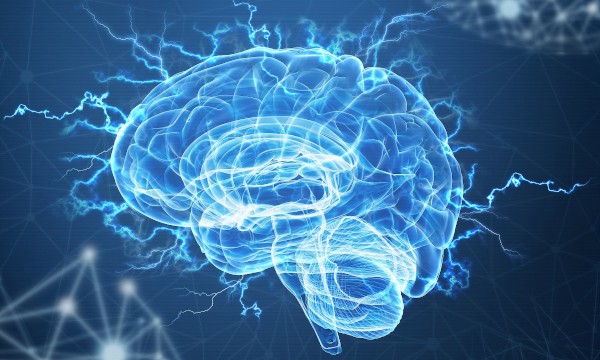
The brain is a network of entangled neurons distributed on the surface of a convoluted hyperbolic manifold, supported by weakly interacting neural dark matter, nourished by fluid flowing through empty space.
Now that we have a brain, let’s boot it up and give it something to compute.
Synapses
Once a neuron has fired, an action potential travels down its axon to the synaptic clefts, where it forms a junction with the dendrites of other neurons.

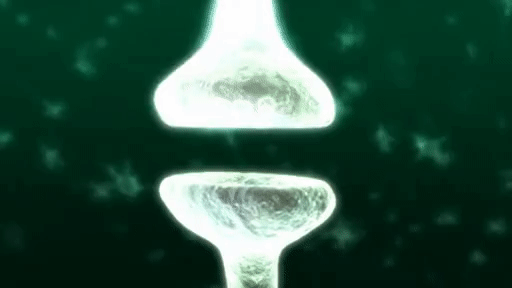
The action potential causes the release of neurotransmitters which attach to receptors on the post-synaptic neuron.
And this opens the gates for electrically charged ions to pass through, creating another action potential which propagates down the axon.
Neurotransmitters
Action potentials can be pretty powerful given enough time for interesting structures to evolve for their transmission. As we have seen, only the organisms most tuned to their environment are capable of sufficiently adapting to ensure their survival and prosperity.
And the tuning of the nervous system in response to the environment is regulated by neurotransmitters . If neurons are the spark plugs of computation, then neurotransmitters are the gas.

As such, they are the catalyst of neural computation , a process occasionally resulting in the formation of a thought.
Controlling the flow of information in the brain with small packets of data, neurotransmitters tune our experience .
Brain Waves
Which bring us to the question, what is experience?
From a computational point of view, once the brain is booted up, information circulates around the nervous system in highly intricate feedback loops, processing sensory data and computing a response to it.

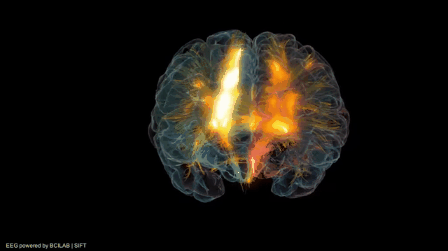
From an electromagnetic point of view, we can visualize this as waves of neural oscillation , distributed across multiple frequency bands , computing different modes of consciousness , that is, different descriptions of the same phenomena.
If neurons are the spark plugs and neurotransmitters the gas, then brainwaves are the algorithm influencing their firing.

The code for consciousness is carried on 6 frequency bands.
Delta (0.5–4 Hz)
Deep, dreamless sleep, non-REM sleep, unconscious.
Theta (4–8 Hz)
Light sleep, deep mediation, creativity, intuition, recall, fantasy
Alpha (8–12 Hz)
Relaxed, light might meditation, creative, learning, conscious
Beta (13–30 Hz)
Normal waking state, concentration, focus, physical senses, integrated
Gamma (30–90 Hz)
Higher cognitive function and motor control
Epsilon (90+ Hz)
Reality modulation and gain control
Harmonic Brain Modes
Tying it all together is harmonic resonance.
Harmonic Brain Modes: A Unifying Framework for Linking Space and Time in Brain Dynamics
A fundamental characteristic of spontaneous brain activity is coherent oscillations covering a wide range of frequencies. Interestingly, these temporal oscillations are highly correlated among spatially distributed cortical areas forming structured correlation patterns known as the resting state networks, although the brain is never truly at “rest.”

Here, we introduce the concept of harmonic brain modes — fundamental building blocks of complex spatio-temporal patterns of neural activity.
We define these elementary harmonic brain modes as harmonic modes of structural connectivity; that is, connectome harmonics , yielding fully synchronous neural activity patterns with different frequency oscillations emerging on and constrained by the particular structure of the brain.
In other words, the structure of the brain naturally gives rise to distributed clusters of neurons that resonate and fire together depending on the frequency of oscillation .
Thereby providing targets for distributed, multi-dimensional, real-time computing.
Lateral Hemispheres
Speaking of harmonic modes of experience — LOL — this is perhaps the brain’s greatest trick. It split itself in two!
Each hemisphere controls the other half of the body and each of them has a distinct point of view.

The left hemisphere is obsessed with analyzing things and fabricating stories. It is the home of logic and language .

The Architect
And the right hemisphere is concerned with the big picture, how things feel, and creativity. It’s more in the here and now, so to speak. As such, the right hemisphere is the seat of intuition .

The Oracle
Corpus Callosum
And connecting the two hemispheres is the corpus callosum, “a wide, thick nerve tract, consisting of a flat bundle of fibers, beneath the cerebral cortex in the brain.”

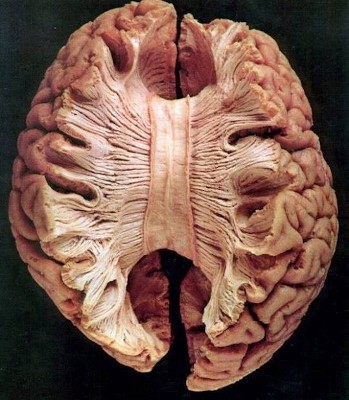
A corpus callosum
The function of the corpus callosum is perhaps illustrated best when we consider the absence of it.
After the right and left brain are separated, each hemisphere will have its own separate perception, concepts, and impulses to act. Having two “brains” in one body can create some interesting dilemmas.
The overlapping of perspectives in our brains, the interference patterns from different points of view, create the experience of depth.
And our experience of consciousness, which exists uniquely expressed on both sides of the brain , seems to be integrated as an interference pattern of the two.
Logic and intuition.
Again, we find different descriptions of the same phenomena.
Consciousness
Perhaps harder than than all of the hard problems in physics is the hard problem of consciousness. David Chalmers summarizes it best:
The really hard problem of consciousness is the problem of experience. When we think and perceive there is a whir of information processing, but there is also a subjective aspect … Why should physical processing give rise to a rich inner life at all?
It seems objectively unreasonable that it should, and yet it does. If any problem qualifies as the problem of consciousness, it is this one.
And there’s no equation for that.
Consciousness — the rich inner life of subjective experience.

In the simplest of terms, consciousness can be thought of as the sentience or awareness of internal or external existence.
And , despite centuries of analyses, definitions, explanations and debates by philosophers and scientists, consciousness remains puzzling and controversial, being “at once the most familiar and most mysterious aspect of our lives.”
Perhaps the only widely held point of agreement concerning consciousness over the millennia is the intuition that it exists.
I think, therefore I am.
An insight which, by the way, was built on visions delivered to Descartes in a series of three visitations by a ‘ divine spirit’ in his feverish dreams.
Descartes saw very clearly that all truths were linked with one another, so that finding a fundamental truth and proceeding with logic would open the way to all science.

Fate, it seems, is not without a sense of irony.
Quantum Consciousness
Like gravity, we know that consciousness exists but yet we remain in the dark with respect to its mechanics.
And it can be argued that classical mechanics arose from the banishment of consciousness from our conception of the physical universe . Since consciousness could not be reduced to equations, subjective experience , like hidden dimensions of the universe, was deemed negligible .
Recognizing this absurdity, a group of scientists put forth a number of hypotheses implying that classical mechanics alone cannot explain consciousness .

As with gravity, a quantum theory is needed for the re-admission of consciousness back into the realm of scientific discovery .
The theories of quantum consciousness postulate that features of quantum mechanics — entanglement, superposition, non-locality, quantum tunneling, the observer effect, and the uncertainty principle — can be used to describe brain function and perhaps even consciousness itself.
Eugene Wigner was the first to suggest that quantum mechanics has something to do with how the brain operates, arguing that the wave function collapses due to its interaction with consciousness .

And Freeman Dyson went further, arguing that “ mind, as manifested by the capacity to make choices, is to some extent inherent in every electron. ”
That consciousness, like gravity, is a fundamental property of the universe .
Holomovement
David Bohm , a notable quantum physicist, interpreted the contradictions of relativity and quantum mechanics as evidence pointing to the need for a deeper, more fundamental model of the universe, one that included consciousness.
In particular, Bohm objected to the assumption that the world can be reduced to a set of irreducible particles within a three-dimensional Cartesian grid, or even within the four-dimensional curvi-linear space of relativity theory. Bohm came instead to embrace a concept of reality as a dynamic movement of the whole:
In this view, there is no ultimate set of separately existent entities, out of which all is supposed to be constituted. Rather, unbroken and undivided movement is taken as a primary notion.
This more fundamental level was proposed to represent an undivided wholeness and an implicate order , from which arises the explicate order of the universe as we experience it.
A deeper and more extensive inner movement creates, maintains, and ultimately dissolves structure.
Coincidentally, at the same time in the early 1970’s, string theory was just beginning its march towards quantum gravity.

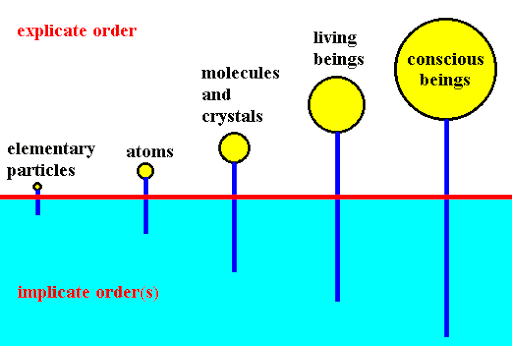
Bohm’s proposed implicate order applies both to matter and consciousness.
He suggested that it could explain the relationship between them. He saw mind and matter as projections into our explicate order from the underlying implicate order.

With the conscious experience of music, for example, Bohm believed that the feeling of movement and change derives from holding the immediate past and the present in the brain together.


The musical notes from the past are transformed rather than being explicitly re-membered. The notes implicate in the preceding moments become explicate in the present, shaping its direction and movement, perhaps implying a choice.

In this model, consciousness emerges into the explicate order — the present — and is distorted by the interference patterns of the implicate order — the past and the future —thereby binding memory and expectation into perception and action.
Consciousness — the awareness of the present — is an entangled state of perpetual enfolding of the past and unfolding of the future.

An ouroboros engaged in the eternal cycle of creation and destruction
Holonomic Brain Theory
In the late 1940’s and early 50’s, Karl Pribram , a neuroscientist, performed defining neuro-behavioural experiments that established the underlying structure of the executive functions of the prefrontal cortex and the limbic system.
In essence, the neural architectures of thought and feeling .
Additionally, he discovered that the sensory-specific association cortex of the parietal and temporal lobes, where associations are made between the body’s senses in real-time, “operate to organize the choices we make among sensory stimuli, and not the sensing of the stimuli themselves.”
But what Pribram is best known for is holonomic brain theory , which describes human cognition by modeling the brain as a holographic storage network , with consciousness being shaped by the quantum effects occurring within and between brain cells.
In 1975, Pribram was inspired by the work of Bohm who had noted that the universe would look like a hologram to us if we did not have the use of lenses .
Building on this insight, Pribram concluded that our view of the world would be a hologram — a diffuse scattering of the interference patterns of electromagnetic waves — if not for the lenses of our eyes.
And that the neural processes of perception are formed by several stages of transformation, each stage having its roots in quantum mechanics.
In a famous collaboration with Bohm that followed, Pribram laid the foundation for a quantum theory of consciousness , connecting Bohm’s theory of holomovment with the mathematics of holography and neuroscience.
Pribram hypothesized that memory takes the form of interference patterns similar to those of holograms produced by a laser.

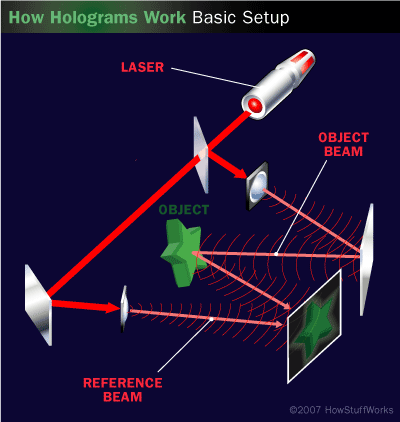
Pribram suggested that cognition involved electrical oscillations in the delicate fibers of the dendritic web , which are different from the more commonly known action potentials of axons and synapses.
In other words, the space between the neurons — and not the neurons themselves — was responsible for consciousness .
Pribram hypothesized that the fluctuations of brainwaves riding on gray matter, glial cells, and the synapto-dendritic web “ create interference patterns in which memory is encoded naturally, and the waves may be analyzed by a Fourier transform.”
And remember, with a hologram, any part of it with sufficient size contains the whole of the stored information.
In this theory, a piece of a long-term memory is similarly distributed over a dendritic arbor so that each part of the dendritic network contains all the information stored over the entire network.

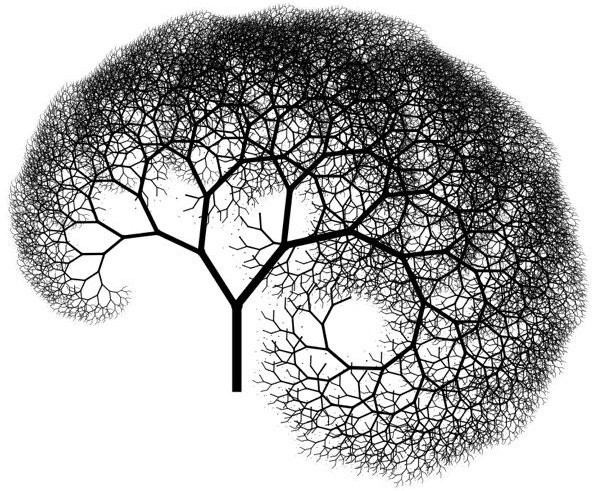
This structuring of the brain provides the capability of responding to stimuli without specialized and constrained paths of nerve conduction.
Instead, the brain operates as a general purpose computer with built-in redundancy, each part receiving information about the whole and performing a specific computation on it — at all scales.

Like many structures found in nature, the brain’s architecture is fractal. And perhaps it follows that the algorithm is as well. Consciousness itself.
In this model, consciousness is expressed by a Fourier transform between the frequency and space-time domains of reality . It’s what reveals the available degrees of freedom with respect to the past and the future —in essence, it’s a function to decide what to pay attention to.

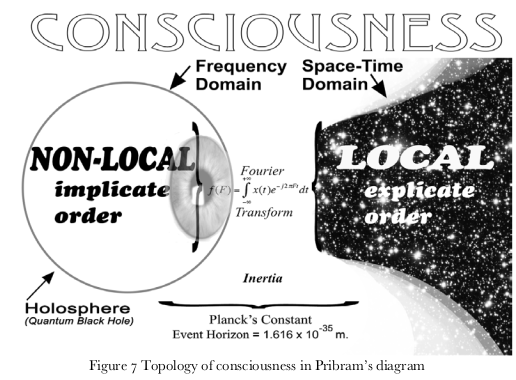
But ultimately, consciousness is really the platform for making a choice . A multi-dimensional awareness of and response to the environment. The basis for an informed decision, at any scale.
Perception, then, is the re-construction of the hologram, a momentary collapse of the wave-function into an explicate order. The filtering and focusing of attention predicated on the past and future.
Perception is the simulation.

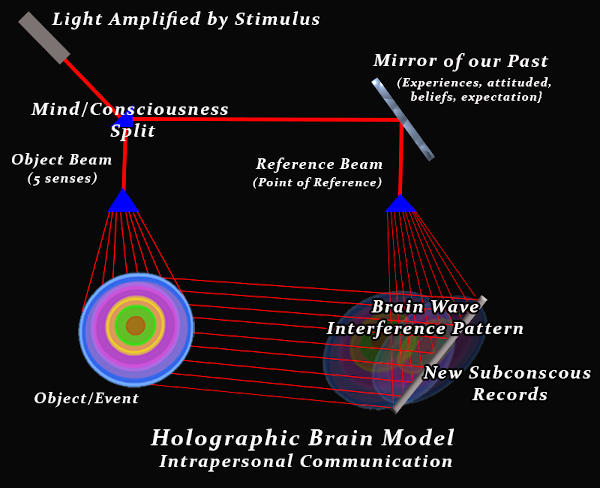
The electrical signals of the nervous system are the read-write interface to the hologram. And consciousness is what illuminates the choices available now, in the present — focusing our attention — distorted and myopic as it may be.
Holographic Associative Memory
In the typical operation of holograms, we shine a reference beam on a holographic film to re-construct the visual image of the object beam, thereby observing a virtual image in the reflected light.


And in theory, we can also reverse the procedure, using the object beam to illuminate the hologram, re-creating the original reference beam.
The light itself.
In this dual mode of operation, a holographic associative memory —HAM, for short— is a form of data storage where information from the object beam and reference beam can be saved and retrieved by associating them with one another in interference patterns. Each part of the pattern contains them both, and each can be used to retrieve the other.

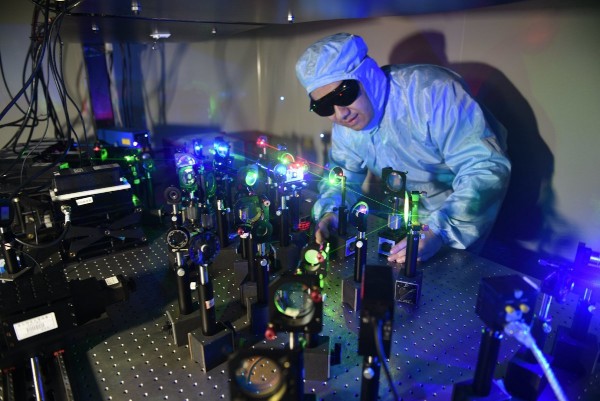
Experimental setup for a 3D holographic storage network
In other words, a hologram with a read-write interface.
HAM is part of the family of analog, correlation-based, associative, stimulus-response memories, where information is mapped onto the phase orientation of complex numbers operating on a Riemann surface.
It can be considered as a complex valued artificial neural network .
The HAM also exhibits some remarkable characteristics, as it has been shown to be effective for associative memory tasks , generalization , and pattern recognition with changeable attention .
And the ability of dynamic search localization is central to natural memory. For example, in visual perception, humans always tend to focus on some specific objects in a pattern. Humans can effortlessly change the focus from object to object without requiring relearning.
HAM provides a computational model which can mimic this ability by creating a representation for focus
Principles of Operation
Link
- Stimulus-response associations are both learned and expressed in one non-iterative transformation . No backpropagation of error terms or iterative processing required.
- The method forms a non-connectionist model in which the ability to superimpose a very large number of stimulus-response patterns or complex associations may be superimposed or “enfolded” on a single neural element.
- The generated phase angle communicates response information, and magnitude communicates a measure of recognition (or confidence in the result).
- The process permits a capability with neural system to establish dominance profile of stored information, thus exhibiting a memory profile of any range — from short-term to long-term memory.
- The process follows the non-disturbance rule, that is prior stimulus-response associations are minimally influenced by subsequent learning.
- The information is presented in abstract form by a complex vector which may be expressed directly by a waveform possessing frequency and magnitude . This waveform is analogous to electro-chemical impulses believed to transmit information between biological neuron cells.
To the point, the universe is a HAM and the brain is it’s tuner.

Inter-dimensional cable TV from Rick and Morty
We’re all tuned into one channel, for better or worse, and it’s called Reality .
Nevertheless, we find consciousness present in both author and audience of the illusion , at the intersection of stimulus and response, expressing itself in the orthogonal dimensions of experience and interaction, exploring and exploiting their degrees of freedom, evolving at all places and at all times, at all scales.

The Hindu goddess Vishnu, both dream and dreamer
Perhaps the Hindus are right.
Holographic Resonance Theory
In summary, we have entangled strings of neurons distributed on a convoluted hyperbolic manifold, supported by weakly interacting grey matter, computing orthogonal modes of experience.

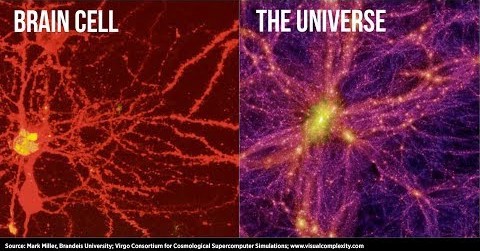
In a universe of quantum entangled strings distributed on a multi-dimensional hyperbolic manifold, supported by weakly interacting dark matter, computing orthogonal dimensions of space-time.

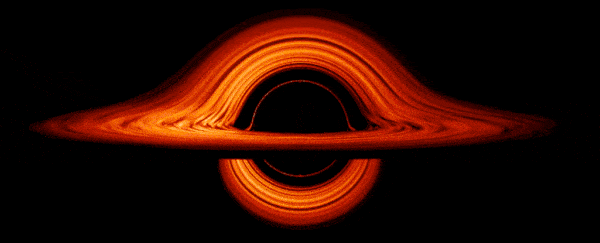
Where at the event horizon, the boundary of space-time, we find standing waves of electromagnetic oscillation, interference patterns from the evolution of complexity.

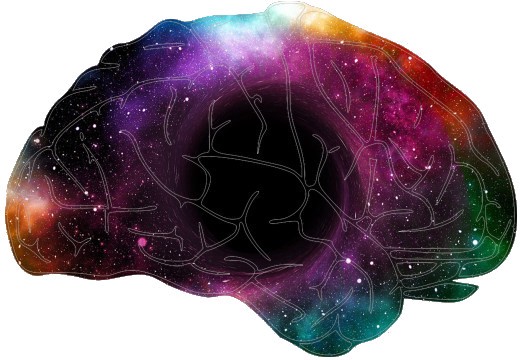
Modes of consciousness carried on brainwave frequency bands.

Brain waves, neurotransmitters, and cortical laminae
Computed in the cortical layers, modulated by neurotransmitters.

Creating a harmonically resonating electromagnetic chord.

Providing a reference beam to read and write the hologram — the universal wave-function — stimulus and response in one iteration.
Computing orthogonal dimensions of experience independently and integrating them as interference patterns, setting the body and mind in motion.
The universe, a black hole, is the computer. Consciousness, surfing on its event horizon, is the agent. The body is the robot, and the brain, more or less, is a wireless network terminal, an antenna for signal broadcast and reception. Furthermore:
The algorithm running all threads of consciousness is to evolve the greatest form of reproducible complexity as fast as possible.
In essence, to level up.
It follows then that the world around us — the illusion created by the brain necessary for survival, where we find the best odds of survival and reproduction, the simulation, what we call reality, etc— is an inverted holographic projection of the first three dimensions of a quantum entangled superstring hyperspace .
The direction of time, the fourth dimension , is restricted to forward only, and affords only a single glimpse as we pass it by.
The fifth dimension is barely visible, if observable at all. Or perhaps it’s just our mental space, deemed negligible by most of science.
And with the sixth dimension and beyond, we must abandon all observation and turn entirely to the imagination.
Or so it seems …
The Psychedelic Experience
Before we dip our toes into the waters of psychedelia, a disclaimer is an order.
In my nearly 45 trips around the sun to date, the number of times I have consumed psychedelic molecules is perhaps half a dozen. All sub-threshold, sub-visual experiences — microdoses, if you will — and which produced a happy, warm, and expansive feeling. A decade or so ago.
In other words, I’ve never tripped.
Nonetheless, I am experienced with tetrahydrocannabinol (THC) and cannabidiol (CBD), and I find that with the proper dosage and administration in conjunction with meditation , they produce similar feelings as to those described above.

Generally, a resonance with the world. More signal, less noise.
So what follows is speculation built on the trip reports of other people’s hallucinations — and therefore not even my own!— and this is coming from someone who enjoys cannabis.
So if you need an escape pod from this already tenuous thread of intergalactic logic, here’s your blue pill.
Otherwise, down the rabbit hole we go.
Serotonin
The first stop we need to make on our trip through wonderland is with serotonin, or 5-hydroxytryptamine (5-HT), a molecule ubiquitous in nearly all forms of life.


A serotonin molecule
Generally speaking, in animals, serotonin mediates the perception of resources while, in plants, it seems to be associated with stress signals.
In more complex animals, such as arthropods and vertebrates, resources also can mean social dominance. And in response to the perceived abundance or scarcity of resources, an animal’s growth, reproduction or mood may be elevated or lowered.
In humans, serotonin is a neurotransmitter used throughout the body and there are 14 variants of its receptor, with some opposing in function.

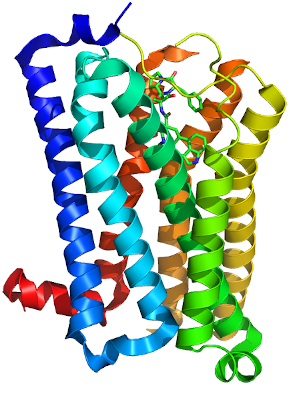
A serotonin (5HT) receptor
And they have diverse effects on the body including: mood, anxiety, sleep, appetite, temperature, eating behaviour, sexual behaviour, movements and gastrointestinal motility .

The function of serotonin in the nervous system seems to be in the tuning of neural firings versus the excitation and inhibition of neurons.
And with its pathways distributed widely throughout the cortex, it is often associated with feelings of well-being and happiness.
Diving deeper, the serotonin sub-receptor identified as 5HT2A, in particular, is excitatory , causing an increase in irregular excitation, essentially having an entropic effect.

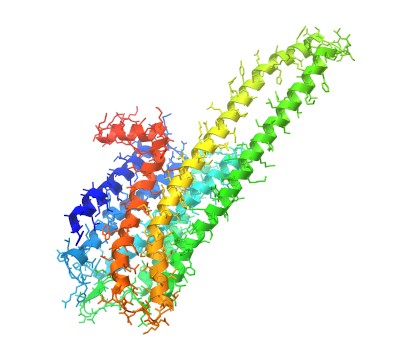
A 5HT2A serotonin sub-receptor
Robin Carhart-Harris has proposed that 5HT2A is a randomness generator and that serotonin is deployed in greater amounts in response to a crisis or emergency.
And at times when increasing the search rate for available options and slowing down time facilitates survival, 5HT2A sure comes in handy.
It’s also the serotonin sub-receptor that psychedelic molecules attach to the most.
Psychedelic Molecules
And perhaps it’s clear why.

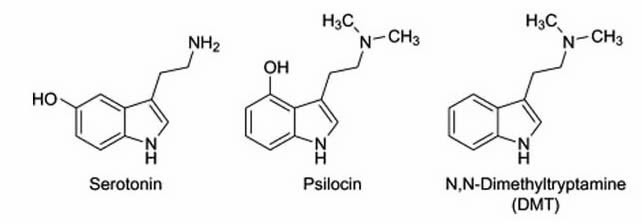
Serotonin, psilocin, and dimethyltryptamine molecules
Psychedelic molecules look a lot like serotonin.
With the fusion of benzene and pyrrole rings , we find a common denominator between serotonin and the psychoactive molecules found in nature , in places like mushrooms, plants, trees, and animals.
If we are looking for a possible conduit of consciousness , a stable molecule with a planar surface and 6 electrons sharing an entangled ring of superimposed orbital structures — an interface to read and write the hologram — then perhaps we have found it in the benzene ring.

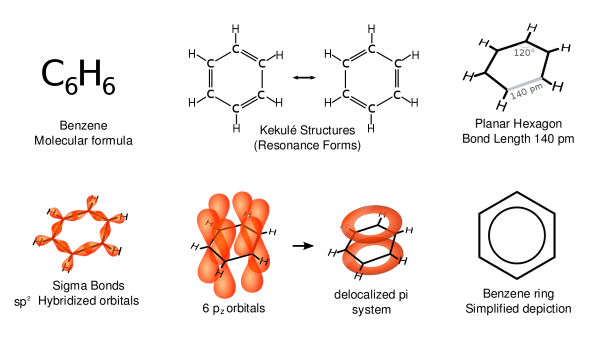
A benzene ring
And if we’re looking for a molecule fused to the benzene ring with a planar surface and 6 electrons sharing entangled orbital structures — though weakly — creating an interface for entropy — then perhaps we have found it in the pyrrole ring.

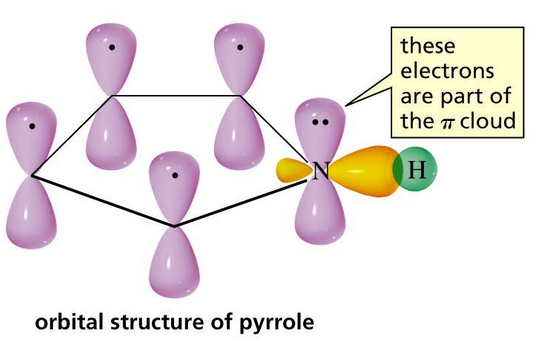
A pyrrole ring
Serotonin, to note, is also the only neurotransmitter with the fused pyrrole ring. Weird, huh?
Anyway, let us not get distracted with details at the moment and press on.
The Psychedelic Trip
Under normal circumstances, the levels of serotonin (and likely DMT) in the brain are precisely tuned to collapse the hologram’s wave-function into what we see around us, balancing the needs for survival against those of the imagination.
With the intake of psychedelic molecules — agonists of the serotonin 5HT2A sub-receptors — we are subjected to a dramatic increase in neural firings throughout the brain . Additionally, they help to prevent the re-uptake of serotonin once it has been secreted, which further increases the firing rate of neurons.
Basically, we are flooding the brain with neurotransmitters and overloading it with signals independent from external stimuli .
Hyper-Connectivity
One consequence of the hyper-activity of the neurons and their increased firing rate is a hyper-connectivity of a large number of brain regions at increased power levels.

The effects of psilocin on the inter-connectivity of brain regions.
A vast number of connections are made throughout the cortex that otherwise would not have been activated. Strongly.
And this is happening all at once.
Altered Brainwaves
Another consequence of the change in neural firing rate, is a change in the brainwaves themselves. As power is increased and redistributed throughout a much broader neural network, the interference patterns and brainwaves are markedly changed.
As proposed, brainwaves are the carrier frequencies of consciousness, computing its modes. And substantial changes in their power should correlate with changes in subjective experience.

Brainwave frequency power spectrum during a DMT trip
And with DMT, we find that they clearly do.
As we can see, power is redistributed to the lower frequency bands, theta and delta — where the subconscious and deep sleep are computed.
And at the peak, the brainwave frequencies commonly associated with awareness and activity, alpha and beta , just … disappear.
If you’re not familiar with the vibe or trajectory of a DMT trip, then I recommend either erowid or 340 DMT Trip Reports to get some grounding.
There’s also 145,000 people on reddit talking about it everyday.
The Hyperbolic Geometry of DMT Experiences
If nothing else, perhaps you will find in the anonymous reports of hallucinations from people around the world a source of great amusement. Maybe even a window into the wonder of the faculties of human imagination and language.
But if you’re a DMT user and interested in hyperbolic geometry like algekalipso and collaborators, then perhaps you will find that you can start breaking the experience down with some math.
We posit that one can account for a wide array of (apparently diverse) phenomena present on DMT-induced states of consciousness by describing the overall changes in the geometry of one’s spatio-temporal representations (what we will call “world-sheets” i.e. 3D + time surfaces ; 3D1T for short).
That is, the changes in consciousness are due to a change in the curvature of the simulation’s space-time geometry.
The concrete hypothesis is that the network of subjective measurements of distances we experience on DMT (coming from the relationships between the phenomenal objects one experiences in that state) has an overall geometry that can accurately be described as hyperbolic (or hyperbolic-like).
The simulation’s space-time geometry is inherently hyperbolic.
In other words, our inner 3D1T world grows larger than is possible to fit in an experiential field with 3D Euclidean phenomenal space (i.e. an experience of dimension R2.5 representing an R3 scene). This results in phenomenal spaces, surfaces, and objects acquiring a mean negative curvature.
Under the influence of psychedelics, the simulation acquires a negative curvature when overloaded with information.
And with heroic doses , the simulation turns itself inside out.

Buckle your seatbelt Dorothy, because Kansas is going bye-bye.
The Geometric Levels of a Psychedelic Trip
From Psychonaut Wiki
1. Visual noise
At the lowest level — which may be experienced in a completely sober state — geometry is perceived as visual noise or static , combined with stray light and dark red regions that appear under the eyelids.
2. Motion and Color
The effect can be described as the appearance of unstructured regions of sudden flashes and clouds of color . These are typically referred to as phosphenes and can often be experienced in a sober state by rubbing or applying pressure on or near the closed eyes.
3. Partially Defined Geometry
At this level, relatively complex shapes and patterns with a vague structure begin to form.
These patterns remain strictly two-dimensional.
Geometry at this level is fine, small, and zoomed out in size with a dark color palette that typically limits itself to only a few different shades, such as blacks, reds, and dark purples.
They are displayed in front of both the open and closed eye visual fields across a flat veil of geometry. However, they are significantly more detailed with the eyes closed or within dark environments.
4. Fully Defined Geometry
At this level, the detail in which the geometry displays itself becomes profoundly complex and fully structured ,
But still remains strictly two-dimensional.
At this point, the geometry becomes larger in size and extremely intricate in detail with a color palette that is nearly limitless in its possibilities .
They are displayed on both the open and closed eye visual field across a flat veil of geometry that floats directly before a person’s eyes, remaining significantly more detailed with the eyes closed or in dark environments.
5. 3-Dimensional Geometry
At this level, the geometry has become fully three-dimensional in its shape and position across the visual field.
This adds a new layer of visual complexity and leaves the geometry sprawled out across the surfaces and objects of a person’s environment instead of merely displaying themselves across a basic and flat veil in front of one’s visual field.
6. Partially Overriding Visual Perception
At this level, the geometry has become so intense, vivid, and bright that it has begun to block out and replace the external world .
The visual perception of a person’s environment begins to be replaced by geometry
With objects and scenery either transforming into complex geometric structures or simply being blocked out and covered by them. From this level of geometry onwards it is even possible to view
Geometry which is perceived to be four-dimensional
or created from new, ineffable, non-euclidean, or nonsensical geometrical principle s, although this is more common at higher levels.
7. Fully Overriding Visual Perception
At this level, the geometry continues to become more intense, vivid, and bright
As it begins t o completely block out or replace the external world
And a person’s sense of normal sight become completely impaired. This creates the perception that one is no longer within the external environment, but has:
“Broken through” into another reality of extremely complex and otherworldly geometric forms.
Level 8A & 8B
At the highest level, geometry is capable of forking off into two separate levels of equal intensity known as level 8A and 8B.
Once visual geometry reaches level 8A or 8B it begins to become:
Structured and organized in a way that appears to present genuine information to the person experiencing it
Far beyond the preceding seven levels of relatively meaningless, although complex, shapes and colours.
This occurs through the perception of innately understood geometric forms that feel as if they depict specific concepts and neurological processes that exist within the brain.
8A. Perceived Exposure to Semantic Concept Network
A level 8A experience can be described as the feeling of being exposed to a seemingly infinite mass of geometry comprised entirely of innately comprehensible representations,which are:
Perceived to simultaneously convey every internally stored concept, memory, process, and neurological structure stored within the mind.

This experience is not just perceived through visual geometric data, but is also felt in an incomprehensible level of detail that manifests in the form of complex cognitive and physical sensations.
These sensations are felt to convey an equal amount of innately understandable information as that of which is also experienced through a person’s vision.
8B. Perceived Exposure to Inner Mechanics of Consciousness
The experience of level 8B can be described as the feeling of being exposed to a mass of geometry comprised entirely of innately readable geometric representations which subjectively feel as if they convey the inner mechanics that compose all underlying neurological processes.
During this experience, the organization, structure, and programming behind a person’s conscious experience are perceived as conceptually understood.

It is generally interpreted by those who undergo it as:
Perceiving the supposed inner workings of either the universe, consciousness, or reality.
This experience as a whole is perceived through innately understood visual geometric data and is also physically felt in an incomprehensible level of detail through accompanying complex cognitive and tactile sensations.
Conclusion
Psychedelic molecules, like gravity, tune the curvature of the simulation. Twist the simulation enough and consciousness pops out on the other side.

Finding itself immersed in an inverted multi-dimensional hyperbolic space-time of entangled energy and information.
And with much greater bandwidth.
A long time ago in a galaxy far, far away, we talked about dark matter:
Dark matter:
- Accounts for 25% of the universe’s energy budget
- Is a background grid of superfluid quantum vortices,
- Entangled primordial axions permeating the universe,
- Having no kinetic energy due to their coupling with the instanton field, the field responsible for quantum tunneling,
- Interacting weakly with matter,
- And occasionally turning into photons
At the center of the benzene and pyrrole rings of serotonin and the psychedelic molecules, we find the entangled orbitals of 6 electrons , all in superposition , encircling a vast sub-atomic ocean of empty space .
Brainwaves rippling along their planar surface.
In the next and concluding piece, we will explore the content of psychedelic trips and the implications of a holographic universe where we find access to at least 6 of the dimensions proposed by string theory .
Having solved the hard problems of physics and consciousness, we will turn our attention to perhaps the hardest problem of them all.
Language.
Regards

